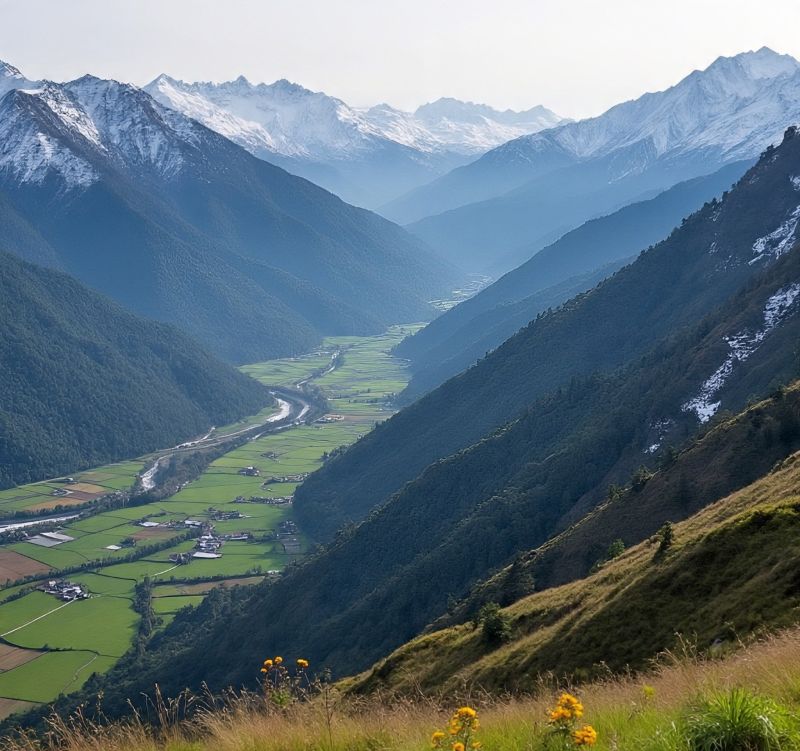Nagaland Boosts Year-Round Travel and Tourism Beyond the Hornbill Festival in India
Nagaland’s untapped tourism potential offers year-round cultural, eco, and adventure experiences. Strategic planning can boost economy, global visibility, and employment.
Observers have frequently described Nagaland as a state with immense yet largely untapped tourism potential, noting that it has struggled to maintain steady visitor numbers despite its diverse attractions. Known for its breathtaking landscapes, vibrant festivals, and rich cultural diversity, the state has historically faced challenges in transforming these assets into sustained tourism growth. The Hornbill Festival, celebrated every December, has become Nagaland’s flagship event, yet tourism largely remains seasonal, concentrated around this ten-day celebration. Experts have suggested that by developing Nagaland into a year-round destination, the state could significantly enhance its global visibility and economic prospects. Investments in infrastructure, strategic marketing campaigns, and active community involvement could establish Nagaland as a hub for cultural tourism and eco-adventures, attracting international travelers seeking authentic experiences. Its ethnic diversity, traditional craftsmanship, and renowned hospitality offer unmatched opportunities for experiential travel, combining adventure with centuries-old heritage and natural beauty.
Analysts emphasize that the present moment is critical for Nagaland to capitalize on these inherent strengths, especially as global travelers increasingly seek immersive and genuine experiences. Tourists today are looking for destinations that offer a blend of culture, adventure, and natural exploration, all of which Nagaland possesses in abundance. Structured tourism strategies and promotion of year-round attractions could markedly increase tourist arrivals, create sustainable employment, and elevate the international profile of India’s North East region.
The Bigger Picture: Economic and Cultural Impact
Experts note that tourism contributes approximately 5% to India’s national GDP, providing livelihoods for millions across sectors such as hospitality, transportation, handicrafts, and culinary services. Observers have drawn comparisons with states like Kerala, where systematic tourism planning has driven significant economic transformation. In Kerala, tourism accounts for over 12% of GDP, supporting more than 1.5 million jobs. Analysts believe that Nagaland could similarly leverage its rich cultural heritage and scenic landscapes to stimulate economic growth while enhancing its global recognition.
Tourism specialists highlight that structured strategies not only generate employment and encourage local entrepreneurship, but also foster a sense of cultural pride among younger generations. Offering international travelers opportunities to engage with Nagaland’s traditional crafts, festivals, and community experiences could further strengthen the state’s identity as a globally significant destination. Experts argue that tourism affects more than just visitor numbers; it shapes regional development, cultural preservation, and community identity formation.
Vision for Year-Round Tourism
Analysts stress that Nagaland’s heavy reliance on the Hornbill Festival limits its full potential. While this festival draws significant attention, experts believe that a more diverse tourism calendar could enhance the state’s appeal. Promoting other tribal festivals across the year, alongside the development of eco-tourism and adventure activities, could establish a robust year-round tourism ecosystem.
Observers note that a steady flow of visitors throughout the year would benefit communities in multiple districts, ease infrastructure pressures during peak seasons, and provide tourists with multiple immersive experiences rather than a single seasonal attraction. A comprehensive tourism strategy could create long-term employment, reinforce cultural identity, and position Nagaland as a destination that seamlessly combines authentic cultural immersion with adventure tourism.
Community Engagement and Sustainability
Tourism experts consistently emphasize that community participation is essential for sustainable tourism growth in Nagaland. Training local populations in hospitality management, tour guide skills, and language proficiency is crucial not only for improving visitor experiences but also for ensuring that economic benefits remain within local communities.
Observers have highlighted that public-private partnerships can support investment in hotels, resorts, and eco-tourism infrastructure, while promoting responsible tourism practices that preserve natural landscapes and reinforce cultural traditions. By fostering inclusive tourism, where local communities actively engage with and benefit from visitor activities, Nagaland can ensure that growth aligns with both economic objectives and cultural sustainability goals.
Harnessing Cultural and Natural Heritage
Experts have consistently remarked that Nagaland’s uniqueness arises from its combination of cultural richness and natural beauty. Its ethnic diversity, village traditions, and centuries-old practices offer immersive experiences that resonate with travelers seeking authenticity.
Analysts propose that cultural tourism could include interactive workshops in weaving, handicrafts, and culinary arts, while eco-tourism initiatives could showcase the state’s forests, hills, and wildlife sanctuaries. By offering a broad spectrum of attractions, Nagaland could reduce reliance on seasonal events, promote balanced visitor distribution, and enhance international appeal. Experts emphasize that combining cultural immersion with nature-based experiences can increase visitor engagement, extend average stay durations, and attract a wider range of global travelers.
Untapped Potential Across Sectors
Tourism analysts have identified several key sectors where Nagaland could effectively leverage its resources:
- Hospitality Services: Expansion of hotels, homestays, resorts, and guesthouses to cater to diverse visitor profiles.
- Guiding and Tours: Creation of roles for cultural guides, adventure coordinators, and nature trail guides.
- Handicrafts: Promotion of Naga shawls, bamboo products, jewelry, and woodwork.
- Culinary Tourism: Offering authentic Naga cuisine and immersive food experiences.
- Adventure and Eco-Tourism: Development of trekking routes, camping zones, birdwatching tours, and nature trails.
- Cultural Experiences: Showcasing village tourism, traditional dances, music performances, and storytelling sessions.
Analysts assert that effectively promoting these sectors could transform Nagaland into a year-round destination, boosting employment, economic growth, and global recognition, while preserving its distinct cultural identity.
The Hornbill Festival and Its Broader Implications
The Hornbill Festival continues to serve as Nagaland’s primary tourism showcase, attracting both domestic and international visitors. Observers note that the meticulous planning and stakeholder involvement in this festival highlight the state’s dedication to tourism promotion.
However, reliance on a single event exposes the state to seasonality risks. Numerous tribal festivals, celebrated at different times across various districts, remain under-promoted. Experts argue that extending promotional efforts to these festivals could establish Nagaland as a year-round cultural hub, ensuring steady visitor inflows, equitable economic benefits, and encouraging repeat international visits. Leveraging the diversity of festivals could sustain tourism growth while maintaining the state’s cultural identity.
Current Gaps and Challenges
Analysts have consistently highlighted several obstacles that restrict Nagaland’s tourism potential:
- Heavy dependence on the Hornbill Festival.
- Limited infrastructure, including poor road connectivity and transport networks.
- Shortage of quality accommodations.
- Minimal digital presence, limiting global awareness.
- Lack of community readiness, with locals often untrained in tourism services.
- Underdeveloped community-based initiatives, restricting economic benefits for residents.
Observers warn that without addressing these challenges, Nagaland risks being perceived primarily as a seasonal destination, despite its rich cultural heritage, diverse festivals, and abundant natural beauty.
Way Forward: Infrastructure, Marketing, and Global Positioning
Experts suggest that realizing Nagaland’s full tourism potential requires collaboration between government authorities and private stakeholders. Recommended measures include:
- Promoting tribal festivals beyond the Hornbill Festival to maintain year-round engagement.
- Expanding eco-tourism, trekking, and adventure tourism to appeal to international audiences.
- Strengthening digital visibility through social media campaigns, virtual tours, and interactive online content.
- Training locals in hospitality, tour guide skills, and language proficiency.
- Encouraging public-private partnerships to develop hotels, resorts, and adventure infrastructure.
Tourism specialists believe these initiatives would not only increase visitor numbers but also create a sustainable tourism ecosystem, fostering economic growth, employment, and cultural preservation.
Global Implications and Opportunities
Observers emphasize that a comprehensive tourism strategy in Nagaland could significantly influence global travel patterns. By offering authentic cultural experiences, eco-adventures, and a range of year-round festivals, the state could attract travelers seeking immersive and distinctive destinations.
Potential outcomes include:
- Establishing Nagaland as a must-visit international destination.
- Encouraging longer stays and increased spending by international tourists.
- Serving as a model for other underexplored regions combining cultural tourism and eco-tourism.
Analysts note that leveraging ethnic diversity, scenic landscapes, and a diverse festival calendar could cement Nagaland’s global reputation and establish it as a leading example of sustainable tourism development in India.
A Hidden Global Treasure
Experts conclude that Nagaland, with its lush green hills, serene valleys, vibrant festivals, and rich cultural heritage, represents one of India’s most promising tourism frontiers. While reliance on a single seasonal event has constrained growth, analysts assert that strategic planning, robust infrastructure, and active community engagement could transform Nagaland into a year-round destination.
Integrating cultural immersion, eco-tourism, and adventure activities could boost economic development, create employment opportunities, and secure a prominent place on the global tourism map. Observers highlight that the state’s combination of scenic beauty, ethnic diversity, and traditional hospitality positions it as a hidden treasure, ready to offer authentic, memorable experiences to travelers throughout the year.
The post Nagaland Boosts Year-Round Travel and Tourism Beyond the Hornbill Festival in India appeared first on Travel and Tour World


Comments and Responses
Please login. Only community members can comment.